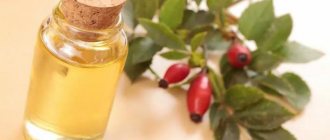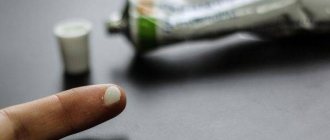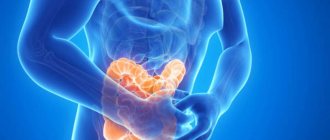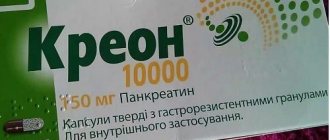Composition and effects
In ophthalmology, drops are intended for topical use. The active ingredient is prednisolone acetate. 1 ml of drops contains 5 mg of active substance. The glucocorticosteroid has antiallergic, immunosuppressive, antipruritic, antiexudative and anti-inflammatory effects.
Prednisolone has a stronger effect than hydrocortisone. Once on the mucous membrane, the substance interacts with glucocorticosteroid receptors and reduces the release of histamine. It also affects the synthesis of proteins, carbohydrates, lipids, calcium and sodium ions.
The substance has a weak vasoconstrictor effect, reducing the increased lumen of blood vessels and their permeability. Prednisolone is aimed at suppressing the inflammatory process, which can be caused by an immune reaction, mechanical or chemical damage.
The local therapeutic effect lasts for 12-36 hours. The active substance is absorbed into the systemic circulation. 3 hours after ingestion, it is processed by the liver and partially excreted in the urine.
All medications with the word “Prednisolone” in the name contain as an active ingredient
prednisolone.
Currently, doctors, pharmacists and patients under the name “Prednisolone” mean the entire set of medications containing prednisolone as the active substance. These drugs are sold under different commercial names, many of which have been registered in the CIS countries over the past 20 years, since before that there was a practice of producing drugs containing the same active substance by different pharmaceutical plants in the cities and republics of the USSR under the same name same name.
Today, many pharmaceutical plants, wanting to protect the drug they produce, register it under a different name, for example, Prednisol, Medopred, etc. This is done so that people, doctors and pharmacists can quickly find out which “prednisolone” is produced by which plant.
Today, medications containing prednisolone are produced and sold under the following trade names:
- Decortin H20, Decortin H5 and Decortin H50;
- Medopred;
- Prednisole;
- Prednisolone;
- Prednisolone bufus;
- Prednisolone-Nycomed;
- Prednisolone-Ferein;
- Prednisolone hemisuccinate;
- Prednisolone sodium metasulfobenzoate;
- Prednisolone sodium phosphate;
- Prednisolone ointment;
- Solyu-Decortin N25, Solyu-Decortin H50 and Solyu-Decortin H250.
In the further text of the article, we will refer to “Prednisolone” as all medications containing the hormone prednisolone as an active substance, regardless of their commercial names.
Prednisolone drugs are available in five dosage forms:
- Tablets for oral administration;
- Solution for intravenous and intramuscular injections;
- Powder for the preparation of solution for injection;
- Ointment for external use;
- Drops or suspension for the eyes.
The tablets contain 5 mg and 1 mg of prednisolone, solution - 30 mg per 1 ml and 15 mg per 1 ml, powder - 30 mg per bottle, ointment - 0.5% and eye drops - also 0.5%. As auxiliary components, drugs of the same dosage form (for example, tablets) may contain different substances if produced by different factories.
Contraindications to the use of Prednisolone drops
Not used for a number of diseases:
- keratitis, chickenpox and other diseases of the cornea and conjunctiva caused by a virus;
- mycobacterial eye infections;
- fungal infections of the eyes;
- suppuration of the eyes;
- corneal epitheliopathy;
- increased intraocular pressure;
- hypersensitivity to one of the components of the drug.
For short-term use of the solution for health reasons, the only contraindication is hypersensitivity to the drug.
Taking tablets, intramuscular and intravenous administration of Prednisolone solutions are contraindicated for the following diseases and conditions:
- Infectious diseases in the active phase caused by viruses, fungi and bacteria (herpes simplex, herpes zoster, chicken pox, measles, amoebiasis, strongyloidiasis, systemic mycosis, tuberculosis);
- Immunodeficiency conditions;
- Post-vaccination period (8 weeks before and 2 weeks after vaccination);
- Lymphadenitis after BCG vaccination;
- Gastrointestinal diseases (peptic ulcer of the stomach and duodenum, esophagitis, gastritis, newly created intestinal anastomosis, ulcerative colitis, diverticulitis);
- Recent myocardial infarction;
- Chronic heart failure in the stage of decompensation;
- Hypertonic disease;
- Hyperlipidemia (increased levels of cholesterol, HDL, LDL and TG in the blood);
- Diabetes;
- Thyrotoxicosis;
- Hypothyroidism;
- Itsenko-Cushing's disease;
- Severe chronic renal or liver failure;
- Nephrourolithiasis (kidney stones);
- Low blood protein levels;
- Osteoporosis;
- Myasthenia;
- Acute psychosis;
- Obesity III – IV degrees;
- Polio;
- Glaucoma;
- Pregnancy and breastfeeding period.
The following conditions are contraindications for intra-articular administration of Prednisolone solution:
- Arthroplasty, undergone some time ago;
- Pathological bleeding;
- Intra-articular fractures;
- Previous infectious-inflammatory process in the joint;
- Infectious diseases of periarticular tissues, including those suffered in the past;
- General infectious disease;
- Periarticular osteoarthritis;
- "Dry" joint;
- Destruction and deformation of the bones of the joint (narrowing of the joint space, ankylosis, etc.);
- Joint instability after arthritis;
- Aseptic necrosis of joint bones;
- Pregnancy.
Contraindications to the use of Prednisolone eye drops are as follows:
- Viral and fungal eye infections;
- Purulent eye infections;
- Trachoma;
- Glaucoma;
- Violation of the integrity of the corneal epithelium;
- Eye tuberculosis;
- Condition after removal of a foreign body from the cornea.
The drug is prescribed by an ophthalmologist after examination and diagnosis. Drops are effective for inflammatory eye diseases of non-infectious origin, as well as for stopping an allergic reaction.
They can be used in the following cases:
- chronic allergic conjunctivitis;
- seasonal conjunctivitis;
- blepharoconjunctivitis;
- allergic keratitis;
- blepharitis;
- iritis;
- iridocyclitis;
- uveitis;
- scleritis;
- episcleritis;
- prevention of the inflammatory process after injuries and surgical interventions.
Contraindications to the use of drops are:
- viral lesions of the cornea and conjunctiva (herpes, tuberculosis);
- infectious and inflammatory eye diseases (conjunctivitis);
- trachoma;
- fungal infections;
- increased intraocular pressure;
- glaucoma;
- recurrent corneal erosion with disruption of the integrity of the epithelium;
- acute purulent processes, including purulent conjunctivitis, purulent corneal ulcer;
- hypersensitivity to the components of the drug;
- pregnancy and lactation.
The drug is suitable for treating children, but only after consultation with a pediatrician and pediatric ophthalmologist. The product is not used during pregnancy. Drops can only be used if the benefit to the mother is greater than the risk to the fetus.
If there is an urgent need for a woman to use prednisolone drops in the postpartum period, then she should stop breastfeeding for a while. This is necessary because hormonal substances enter not only the blood, but also into breast milk.
Effects of Prednisolone (therapeutic effect)
Side effects are not typical for the drug. They are often observed due to non-compliance with the treatment regimen. Immediately after administering the drops, a slight burning sensation may be felt, which quickly passes. This feeling is considered normal.
Negative manifestations include:
- discomfort in the eyes;
- tingling;
- itching or burning;
- swelling of the eyelids;
- hyperemia;
- lacrimation;
- photophobia;
- decreased visual acuity;
- narrowing of visual fields;
- mydriasis (dilated pupils);
- ptosis (drooping of the upper eyelid).
Also, side effects of Prednisolone occur from using the drug for more than 10 days. In this case, eye pressure may increase and glaucoma may form. This is a common side effect of corticosteroid use. With long-term use of Prednisolone (more than 3 months in a row), the patient develops posterior capsular cataracts.
- Anti-inflammatory effect, which consists in the rapid and effective relief of the inflammatory process of any localization and intensity;
- Antiallergic effect, which consists in the rapid cessation of the development of an allergic reaction and its manifestations, such as spasm, swelling, skin rashes, etc.;
- Anti-shock effect, which consists of relieving shock in order to prevent death;
- Antiexudative effect, which consists in suppressing the active process of exudation (exudation of inflammatory fluid from tissues);
- Antiproliferative effect, which consists in suppressing the active proliferation of cells in the area of damage, which prevents the formation of scar thickenings in the walls of organs;
- Antipruritic effect, which consists in eliminating the sensation of itching provoked by allergic or inflammatory reactions;
- Immunosuppressive effect, which consists of suppressing the immune system and creating artificial immunodeficiency.
For clinical use, all effects of Prednisolone are important with the exception of immunosuppressive, which is considered rather as a side effect. The therapeutic effects develop very quickly, which allows the drug to be used in critical situations, when it is necessary to normalize a person’s condition literally within 5–10 minutes, stopping the further development of massive edema, spasm of the respiratory organs and inflammatory infiltration of the organ wall.
Since Prednisolone has a very powerful effect, it is used only in severe cases when other medications (for example, non-steroidal anti-inflammatory drugs, antihistamines, etc.) do not have the desired effect. If it is possible to maintain a normal condition and prevent the worsening of the disease not with Prednisolone, but with other, “weaker” drugs, then this is exactly what you should do.
READ MORE: How to relieve red eyes. How to get rid of red eyes quickly. How to relieve red eyes at home
In addition to the listed therapeutic effects, Prednisolone can have the following pharmacological effects:
- Increases protein breakdown, reducing its concentration in blood plasma and tissues;
- Increases protein synthesis in the liver;
- Suppresses active growth in children by increasing the breakdown of proteins;
- Leads to the redistribution of fat, increasing its deposition on the face and upper body;
- Increases blood glucose levels;
- Retains water and sodium in the body, which contributes to the formation of edema;
- Removes potassium from the body and reduces its absorption in the intestines;
- Increases brain excitability;
- Reduces the threshold of convulsive readiness, as a result of which convulsions can develop in a person more often when exposed to stimuli of relatively low strength;
- Inhibits the synthesis of its own glucocorticosteroids by the adrenal glands;
- Inhibits the synthesis of thyroid-stimulating and follicle-stimulating hormone (TSH and FSH).
These pharmacological effects are almost never used for therapeutic purposes, but since they are the basis of the side effects, they are always taken into account for an adequate assessment of the body’s condition during the use of Prednisolone.
- Edema and sodium retention in the body;
- Decreased potassium concentration in the blood;
- Increased concentration of glucose in the blood and urine;
- Weight gain.
- Muscle weakness;
- Myopathy;
- Loss of muscle mass;
- Osteoporosis;
- Compression fracture of the spine;
- Aseptic necrosis of the head of the femur or humerus;
- Long bone fractures.
- Increase or decrease in the degree of pigmentation;
- Subcutaneous or cutaneous atrophy;
- Abscess;
- Acne;
- Slow wound healing;
- Thinning of the skin and stripes of atrophy;
- Petechiae;
- Ecchymosis;
- Erythema;
- Sweating.
- Dermatitis;
- Hives;
- Anaphylactic shock.
- Weakness;
- Fainting;
- Withdrawal syndrome;
- Masking infectious diseases.
Prednisolone ointment
When using Prednisolone ointment, the following side effects may occur:
- Acne;
- Purpura;
- Telangiectasia;
- Burning and itching on the skin;
- Irritation and dry skin;
- Skin atrophy;
- Hypertrichosis (excessive hair growth).
With prolonged use of the ointment or when applying it to large areas of the skin, systemic side effects that are typical for tablets and injections may develop.
Prednisolone eye drops can cause the following side effects:
- Increased intraocular pressure;
- Damage to the optic nerve;
- Posterior subcapsular cataract;
- Impaired visual acuity;
- Narrowing of the field of view (fogging, loss of vision);
- Pain in the eyes;
- High risk of corneal perforation;
- Spread of viral and fungal infections of the eye.
After use, the patient may feel a burning sensation that goes away on its own.
When treated for more than 10 days, there is a risk of increased intraocular pressure. If therapy exceeds 3 months, the development of posterior capsular cataract cannot be excluded.
Clinical picture of the disease
All symptoms of intestinal infection are divided into general and local. Common signs include intoxication and dehydration.
When intoxicated, the temperature rises, headache, weakness and vomiting appear. When dehydrated, the skin and mucous membranes become dry, the elasticity of the skin decreases, and there is less urine and it darkens.
With local symptoms: loose stools, abdominal pain, vomiting.
Symptoms will manifest as damage to the stomach (gastritis), small and large intestines. In some cases, one or the other is affected, but often it occurs in combination. The clinical picture will depend on this.
Instructions for use
Symptoms of overdose include increased side effects. The development of allergic reactions may occur. In such a situation, treatment is stopped.
When using the medicine internally in large quantities, diarrhea, nausea, vomiting and other negative reactions may develop. If you notice any signs, call a doctor. Gastric lavage may be necessary.
The duration of treatment and the frequency of instillations (instillations) are determined by the doctor. Typically the regimen looks like this – 1-2 drops of the drug 3-4 times a day. In acute conditions, the solution can be used every 2-4 hours until the symptoms become less severe. The course of treatment is from 5 to 10 days.
To prevent inflammation after injuries, one instillation per day is sufficient. After surgery, drops are prescribed for 3-5 days, 2-3 times a day. During treatment, it is important to check intraocular pressure, especially if the course lasts more than 10 days.
The drug is injected into the conjunctival sac. When instilling, you should maintain sterility and do not touch your eyes or the tip of the bottle with dirty hands.
If the patient wears contact lenses, they should be removed before instillation. You can put it on no earlier than 20 minutes after the procedure. An opened bottle can be stored for no more than 2 months. After this period, the drops cannot be used.
To avoid side effects from using prednisolone, you must follow the dosage. When it is exceeded, local allergic reactions appear, for example, itching, burning, hyperemia, redness, lacrimation.
If such symptoms occur, instillations should be stopped immediately, otherwise the side effects will only intensify. It is necessary to rinse the eyes with warm water until the symptoms disappear completely. You definitely need to visit an ophthalmologist. Systemic reactions when using drops in ophthalmology are excluded.
Regarding the use of any form of Prednisolone, the following simple and immutable rule should be used - use the drug in the lowest effective dose and for the shortest possible period of time, which is sufficient to relieve the acute condition. Remember that Prednisolone is an “acute condition” drug, and it is not intended for long-term course use due to numerous, very dangerous and severe side effects. Therefore, after relieving the acute condition with Prednisolone, you should switch to taking other drugs intended for course use.
Let's consider the rules for using various dosage forms of Prednisolone separately.
Take the tablets with a small amount
, swallowing whole, without chewing or biting. Prednisolone tablets should be taken in the morning from 6-00 to 8-00 am, strictly after meals. If it is impossible to take the drug at this time, then this should be done before 12-00, since it is in the morning hours that Prednisolone has the most pronounced therapeutic effects.
At the beginning of treatment for acute and severe conditions, you should take 50–75 mg (10–15 tablets) per day, and for chronic diseases – 20–30 mg per day (4–6 tablets). After normalization of the condition, the dosage of Prednisolone is reduced to 5–15 mg per day and the tablets are continued. The duration of treatment is determined by the doctor and depends on the general condition of the person and the effectiveness of the therapy.
For children, the dosage is calculated individually based on body weight, based on the ratio of 1–2 mg per 1 kg of weight to begin treatment, and 0.25–0.5 mg/kg for a maintenance dose.
The solution can be administered intramuscularly, intravenously or intraarticularly. The dosage and method of administering Prednisolone injections are determined by the doctor individually in each case, taking into account the type of pathology, the location of the affected organ and the availability of a possible period of time to relieve severe symptoms. During treatment, the dosage and method of administration of the solution may change depending on the person's response to therapy.
READ MORE: Sand in the eyes of a drop
The optimal way to administer Prednisolone solution is intravenous injection. This means that for various diseases and conditions, the method of choice for administering the solution is intravenous. Intramuscular administration of Prednisolone should be carried out only if it is impossible to perform an intravenous injection. Intra-articular administration of Prednisolone is indicated exclusively for diseases and conditions that affect the tissues inside the joint.
When swelling, inflammation and exudation in the joint decrease, Prednisolone injections can be replaced with tablets, which should be taken until stable remission develops.
Since normally in the human body the adrenal glands release glucocorticoid hormones into the blood between 6-00 and 8-00 in the morning, injections should be made at the same time. That is, the optimal time for injecting the solution is between 6-00 and 8-00 in the morning. It is recommended to administer the entire dosage of the hormone at one time in the morning.
In case of shock, 50–150 mg of Prednisolone (2–5 ml of 3% (30 mg/ml) solution) is administered at a time. The same amount of solution is reintroduced every 3 to 4 hours during the first 24 hours. After this, the doctor determines whether there is a need to continue Prednisolone injections or whether they can be stopped. In case of acute adrenal and liver failure, as well as allergic reactions, 100–200 mg of Prednisolone is administered every 8 hours.
For children, the daily dosage is calculated individually, depending on age and body weight:
- Children 2 – 12 months – 2 – 3 mg per 1 kg of weight;
- Children 1 – 14 years old – 1 – 2 mg per 1 kg.
Prednisolone in the indicated dosages is administered once, and if there is no effect within 20–30 minutes, it is administered again. Administration of Prednisolone is not allowed for more than 24 hours.
The dosage of Prednisolone for intra-articular administration is determined by the size of the joint:
- In large joints – 25 – 50 mg;
- In medium-sized joints – 10 – 25 mg;
- Small joints – 5 – 10 mg.
Intravenous injection of Prednisolone is performed in two ways - stream and drip (“dropper”). Moreover, in the first hours after the development of an acute condition, Prednisolone is administered as a jet, that is, a vein is pierced, a needle is inserted into it, and the solution is released from the syringe. This jet injection of the solution is continued as long as it is necessary to obtain a very rapid effect.
Intramuscular injection is performed according to general rules. That is, the solution is injected into the outer lateral upper part of the thigh, the upper third of the shoulder, or into the stomach if the person is slim. Before injection, the injection area is wiped with an antiseptic, after which the solution is drawn into a syringe and the needle is inserted deep into the tissue perpendicular to the skin. By pressing the piston, the solution is released into the muscle, the needle is removed, and the skin is again wiped with an antiseptic.
Dosages of Prednisolone for various diseases in the form of an injection solution are as follows:
- Acute adrenal insufficiency - single dosage 100 - 200 mg, daily dosage - 300 - 400 mg;
- Severe allergic reactions – 100 – 200 mg per day for 3 – 16 days;
- Bronchial asthma – 25–35 mg per day for 3–16 days (in case of severe disease and no improvement within 2 days, the dosage can be increased to 50–70 mg per day);
- Asthmatic status – 500 – 1200 mg per day;
- Thyrotoxic crisis - 200 - 300 mg per day (if necessary, the dosage is increased to 1000 mg) for 2 - 6 days;
- Shock – 50–150 mg every 4 hours for 1–2 days;
- Acute renal or liver failure - 25 - 75 mg per day;
- Rheumatoid arthritis and systemic lupus erythematosus – 75–125 mg per day for 7–10 days;
- Acute hepatitis – 75–100 mg per day for 7–10 days;
- Poisoning with cauterizing liquids, burns of the gastrointestinal tract and respiratory system - 75 - 400 mg per day for 3 - 18 days.
Start of reception
You should start taking Prednisolone in any form (tablets and solution) for various diseases, with the exception of life-threatening conditions, with the minimum possible dosage, which, if there is no effect, is increased by 25–50% daily. In case of danger to life, Prednisolone is administered immediately in the required dose.
Withdrawal of the drug
If the drug has been taken for more than 5 days, it should be discontinued gradually so as not to provoke withdrawal syndrome. Typically, the dosage is reduced by 3–5 mg every 2–3 days, bringing it to 1–5 mg per day. After this, the drug is taken for another 2–3 days and completely discontinued.
The ointment is applied in a thin layer to the affected areas of the skin 1 - 3 times a day for 6 - 14 days. The use of the ointment should be discontinued as soon as the therapeutic effect is achieved. It is not recommended to apply the ointment under a tight bandage, as this may cause the absorption of a large amount of ointment into the bloodstream with the development of systemic side effects. The ointment should not be used for longer than 14 days without breaks.
The solution is applied 1 - 2 drops into the conjunctival sac, which is formed when the lower eyelid is pulled downwards. Drops are used 3 times a day, and in acute conditions - every 2 to 4 hours. If eye surgery has been performed, then Prednisolone drops can be used only 3–5 days after the operation. Therapy is stopped as soon as the condition improves.
Prevention
There is currently no vaccine developed against norovirus. But in any case, preventive measures are less expensive and time-consuming than curative measures. Prevention of norovirus infection involves taking measures to prevent infection:
- Compliance with individual sanitary and hygienic standards and rules,
- Drinking boiled water
- Washing vegetables and fruits with a brush and soap and then scalding them with boiling water,
- Thermal processing of food products,
- Maintaining adequate sanitary conditions in the apartment,
- Frequent ventilation of the room,
- Daily wet cleaning with disinfectants in the room where the patient is located,
- Treating hard surfaces that the patient may have come into contact with
- Boiling dishes and personal belongings of an infected person,
- Air disinfection in crowded places using a bactericidal irradiator.
Any contact with sick people can lead to infection of healthy people. To prevent this, you should avoid close contact with infected people and treat clothing and areas of the body that may have come into contact with infected biomaterial.
special instructions
Do not use the medicine in contact lenses. Before use, the lenses are removed and put on no earlier than 15 minutes later.
Regular changes in intraocular pressure are recommended when using drops for more than 14 days.
If the eyes are affected by infection, use complex therapy (together with antibiotics).
Drops can be used during pregnancy after consultation with a specialist.
The drug should not be used by women who are breastfeeding, because the components of the drug penetrate into the milk. When treating with drops, you need to stop natural feeding of the baby.
There are no special instructions for people who have impaired kidney function. If the organ is not functioning properly, you should consult a doctor before starting treatment.
Use in children
Contraindicated for treating children.
Special diet (basic provisions)
- To soothe irritable bowels, fasting is recommended, but strictly within the framework of the diet. Uncontrolled fasting will weaken the body and it will not have the strength to fight the disease.
- Oatmeal and rice porridge without salt soothe the intestines and do not provoke the development of microorganisms.
- For mild forms of infections, there are no special restrictions on food intake, but the usual portion should be reduced by about 1/3.
- The following foods are completely excluded from the diet:
- citrus fruits (any);
- milk, fermented baked milk, yogurt (any) and cream;
- black bread;
- beets, peas, beans;
- any fish or meat broths.
- pumpkin, carrots, blueberries, bird cherry;
- slimy soups;
- mashed porridge;
- rosehip decoction;
- jelly;
- dried bread;
- drinking plenty of fluids.
- What should be in the patient’s diet:
All food is prepared only by steaming or boiling. Fried food is strictly prohibited!
Interaction with other drugs
Glucocorticosteroids can be used as part of complex therapy. They are compatible with a group of non-steroidal anti-inflammatory drugs, other glucocorticosteroids, antihistamines, anticoagulants, and diuretics.
But when taken simultaneously, it should be taken into account that Prednisolone will enhance or weaken their effect. If there is a need to use other ophthalmic drugs, it is necessary to maintain a break of 30 minutes.
Hormonal eye drops relieve the symptoms of a fungal, bacterial or viral infection, but do not eliminate the problem. Usually, after a full course of treatment, symptoms return, so etiotropic therapy must be carried out simultaneously with Prednisolone.
READ MORE: Eyes fester and itch in an adult
Prednisolone increases intraocular pressure and the development of glaucoma. The likelihood of this disease occurring increases if the hormonal drug is used simultaneously with antihistamines, antidepressants and anticholinergics.
When combining Prednisolone, psychotropic medications or certain immunosuppressants, for example, Azathioprine, the risk of developing cataracts increases significantly.
Glucocorticosteroids can affect the effectiveness of a number of medications. Parallel use with anticoagulants provokes blood thinning.
When used with diuretics, there is a risk of electrolyte imbalance.
Hormonal contraceptives enhance the effect of Prednisolone with long-term use.
Nausea and vomiting may be negative reactions to the drug.
When using the medicine internally in large quantities, diarrhea may develop.
When taken together with rifampicin, antihypertensive drugs, coumarin and derivatives of the substance, the therapeutic effect of the latter will be reduced.
Hormonal contraceptives enhance the effect of Prednisolone with long-term use.
Features of the treatment of intestinal infections in children
Prevention of dehydration. Only a small number of intestinal infections in children are treated with antibiotics. Most go away on their own, under the pressure of the child’s immune system, which after a few days develops the necessary protection against the disease. The task of the child’s body is to survive these few days. And the most dangerous risk for a child at this time is not the activity of harmful microbes or bacteria, but banal dehydration.
If parents know exactly how to protect their child’s body from dehydration, their baby will not be afraid of almost any intestinal infection.
We will tell you below and in as much detail as possible how and what to give a child to drink during an intestinal infection.
Fighting high fever. We are accustomed to thinking that there is no need to bring down a child’s elevated body temperature, for example, during ARVI, if it has not exceeded 38° C. However, in the case of intestinal infections in children, it is not only possible, but also necessary to bring down the elevated temperature. Mainly precisely because fever provokes significant fluid loss from the body, and dehydration is especially dangerous during intestinal infections in children.
If a child has an intestinal infection accompanied by an increase in body temperature, he needs to be given an antipyretic drug to avoid dehydration and intoxication of the body. But besides this, it is extremely important to constantly water the child.
Remember: the higher the baby’s body temperature during an intestinal infection, the more intensively he needs to be fed!
Treatment of intestinal infections in children with antibiotics. We have already mentioned that only a small percentage of intestinal infections require the use of antimicrobial agents in treatment. Moreover, the use of antibiotics for intestinal infections is strictly regulated by WHO.
So, the indications for the use of antibiotics for intestinal infections in children, approved by the World Health Organization:
- Hemocolitis (in other words, an admixture of blood in stool or vomit);
- Severe forms of cholera.
- Prolonged diarrhea (which lasts for several days in a row) when diagnosed with giardiasis is a disease caused by parasites in the small intestine.
Only in these three cases is the use of antibiotics for an intestinal infection in a child justified and effective. In all other cases, antimicrobial therapy is practically meaningless and unfounded.
Treatment of intestinal infections in children using sorbents. There is some reason for the use of sorbents (special medications that can selectively absorb most poisons, toxins and other harmful substances inside the gastrointestinal tract) for intestinal infections - they really, thanks to their absorption ability, can rid the body of an excess of toxins, gases and other “harmful substances” .
Alas, the WHO does not have any instructions regarding the use of sorbents for intestinal infections in children (since there is no direct evidence yet of the advisability of using such drugs). However, many practicing pediatricians believe that the use of sorbents actually helps to some extent protect the child’s body from dehydration and intoxication due to intestinal infections. There is no consensus yet, but in any case, no one has yet been able to prove that the use of sorbents is clearly harmful to the body.
Well-known pediatrician, Dr. E. O. Komarovsky: “The use of sorbents for intestinal infections in children is definitely moderately effective”










